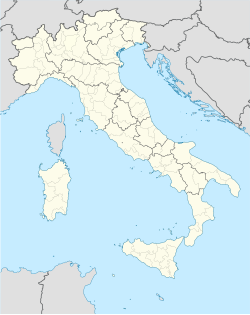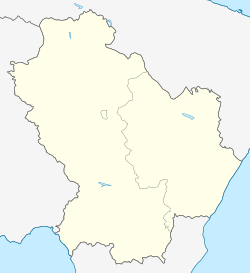Tricarico
Please add Greek script to this article, where needed. |
You can help expand this article with text translated from the corresponding article in Italian. (January 2022) Click [show] for important translation instructions.
|
Tricarico
Trëcàrëchë (Neapolitan) | |
|---|---|
| Comune di Tricarico | |
 Norman tower and Monastery of Santa Chiara | |
| Coordinates: 40°37′N 16°9′E / 40.617°N 16.150°E | |
| Country | Italy |
| Region | Basilicata |
| Province | Matera (MT) |
| Frazioni | Calle |
| Government | |
| • Mayor | Vincenzo Carbone |
| Area | |
• Total | 178.16 km2 (68.79 sq mi) |
| Elevation | 698 m (2,290 ft) |
| Population (March 2009)[2] | |
• Total | 5,920 |
| • Density | 33/km2 (86/sq mi) |
| Demonym | Tricaricési |
| Time zone | UTC+1 (CET) |
| • Summer (DST) | UTC+2 (CEST) |
| Postal code | 75019 |
| Dialing code | 0835 |
| Patron saint | St. Potitus |
| Saint day | 14 January |
| Website | Official website |
Tricarico (Lucano: Trëcàrëchë IPA: [trəˈkæːrəkə]; Greek: Triakrikon)[citation needed] is a town and comune in the province of Matera, Basilicata, southern Italy.
It is home to one of the best preserved medieval historical centres in Lucania.

Etymology
[edit]The origin of the name Tricarico is unknown. It might derive from the Greek treis ("three") and cara (head/skull in Hellenistic-era Greek: η κάρα, τό κάρα, η κάρη). That is "having three heads". According to a slightly different hypothesis, it could have originally been Triacricon, deriving from the Greek words tria/treis and acron/acra, which during Antiquity and Early Middle Ages meant both an "apex/summit", and a "citadel", with Triacricon thus meaning a city made by connecting "three citadels". These three acra/citadels were no other than the site of the 9th c Arabic castle of Saracena in the north, the site of a 9th-10th c Byzantine Rocca fortificata in the south, improved during the 11th-12th c by the Normans, and then, during the 13th c, by the Hohenstaufen, and also the site of the 14th c Palazzo Ducale in the middle. Probably the three sites were simultaneously fortified even before the successive occupations.

History
[edit]Although of ancient origin, the first news documented about the town dates to 849, when it was a Lombard county included in the gastaldate of Salerno. Later (9th century - late 10th century) it was an Arabic stronghold. The terrace gardens, of Arabic origin, are still in use today. In 968 Tricarico was conquered by the Byzantine Empire, and then, in 1048, it became a Norman fortified town.
In the 15th century, there was a Jewish community.
Main sights
[edit]This section is written like a travel guide. (January 2022) |

The roads and alleys of the historical center reflect the Arabic quarters of the Ràbata and the Saracena.
Sights in the town include:
- Cathedral of the Assunta, built by Robert Guiscard. Here, in 1383, Louis I of Anjou was crowned king of Naples.
- Norman tower, with a height of 27 metres (89 ft).
- Towers of Ràbata and Saracena.
- Ducal Palace, now home to the archaeological museum
- Sanctuary of Madonna di Fonti
The archaeological area of Civita is situated outside the city. It includes a Roman fortified center that extends for approximately 50 hectares (120 acres) and consists of stone buildings with squared blocks, fortified with monumental doors. In the interior, some rooms have mosaic pavements over 2,500 years old.
Also present is the Cerra del Cedro archaeological site, inhabited from as early as the 6th century to the 3rd century BC.
References
[edit]- ^ "Superficie di Comuni Province e Regioni italiane al 9 ottobre 2011". Italian National Institute of Statistics. Retrieved 16 March 2019.
- ^ "Popolazione Residente al 1° Gennaio 2018". Italian National Institute of Statistics. Retrieved 16 March 2019.



